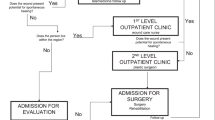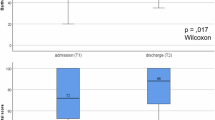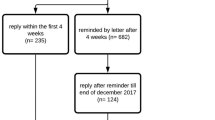Abstract
Study design:
Clinical cohort study.
Objective:
To evaluate if the impact of the severity of the trauma as a possible confounding factor influences the neurological and functional recovery in paraplegia during the course of a 6-month follow-up period after injury.
Setting:
Spinal Cord Injury Center, Heidelberg University Hospital, Germany.
Methods:
A retrospective monocentric analysis, from 2002 to 2008, of the Heidelberg European Multicenter Study about spinal cord injury database was performed. We included 31 paraplegic patients (neurological level T1–T12) who were assigned either to a monotrauma (polytraumaschluessel (PTS) 1) or to a polytrauma (PTS⩾2) group. The American Spinal Injury Association Impairment Scale, lower extremity motor score, pin prick, light touch and the spinal cord independence measure (SCIM) were obtained at five distinct time points after trauma. Data were analyzed using Mann–Whitney U-test (α<0.05).
Results:
The changes in lower extremity motor score, pin prick and light touch showed no significant differences in both groups over the whole evaluation period. Polytraumatic paraplegics showed a significantly delayed increase of SCIM between 2 and 6 weeks compared with monotraumatic patients, followed by a quantitative increase in the subitems bladder management, bowel management, use of toilet and prevention of pressure sores between 3 and 6 months (P=0.031). The mean length of primary rehabilitation in the polytrauma group was 5.5 vs 3.6 months in monotrauma.
Conclusions:
The prognosis of polytraumatic paraplegics in terms of neurological recovery is not inferior to those with monotrauma. Multiple-injured patients need a prolonged hospital stay to reach the functional outcome of monotraumatic patients.
Similar content being viewed by others
Log in or create a free account to read this content
Gain free access to this article, as well as selected content from this journal and more on nature.com
or
References
Champion HR, Copes WS, Sacco WJ, Lawnick MM, Keast SL, Bain Jr LW et al. The major trauma outcome study: establishing national norms for trauma care. J Trauma 1990; 30: 1356–1365.
Hebert JS, Burnham RS . The effect of polytrauma in persons with traumatic spine injury. A prospective database of spine fractures. Spine 2000; 25: 55–60.
Blauth M, Knop C, Bastian L, Krettek C, Lange U . Complex injuries of the spine. Orthopäde 1998; 27: 17–31.
Schinkel C, Frangen TM, Kmetic A, Andress HJ, Muhr G, AG Polytrauma der DGU . Spinal fractures in multiply injured patients: an analysis of the German Trauma Society's Trauma Register. Unfallchirurg 2007; 110: 946–952.
Curt A . Neurologische und funktionelle Erholung nach Querschnittlähmung. Verlaufs- und Beurteilungsstandards in der Paraplegiologie. Orthopäde 2005; 34: 106–112.
Pollard ME, Apple DF . Factors associated with improved neurological outcomes in patients with incomplete tetraplegia. Spine 2003; 28: 33–38.
Marino RJ . International Standards for Neurological and Functional Classification of Spinal Cord Injury. American Spinal Injury Association: Chicago, 2000.
Boerger TO, Limb D, Dickson RA . Does ‘canal clearance’ affect neurological outcome after thoracolumbar burst fractures? J Bone Joint Surg Br 2000; 82: 629–635.
Rahimi-Movaghar V . Efficacy of surgical decompression in the setting of complete thoracic spinal cord injury. J Spinal Cord Med 2005; 28: 415–420.
Ambrozaitis KV, Ambrozaitis KV, Spakauskas B, Vaitkaitis D . Pathophysiology of acute spinal cord injury. Medicina (Kaunas) 2006; 42: 255–261.
Curt A, Van Hedel HJ, Klaus D, Dietz V, EM-SCI Study Group. Recovery from a spinal cord injury: significance of compensation, neural plasticity, and repair. J Neurotrauma 2008; 25: 677–685.
Curt A, Schwab ME, Dietz V . Providing the clinical basis for new interventional therapies: refined diagnosis and assessment of recovery after spinal cord injury. Spinal Cord 2004; 42: 1–6.
Oestern HJ, Tscherne H, Sturm J, Nerlich M . Klassifizierung der Verletzungsschwere. Unfallchirurg 1985; 88: 465–472.
Teijink JA, Dwars BJ, Patka P, Haarman HJ . Scoring multitrauma patients: which scoring system? Injury 1993; 24: 13–16.
Magerl F, Aebi M, Gertzbein SB, Harms J, Nazarian S . A comprehensive classification of thoracic and lumbar injuries. Eur Spine J 1994; 3: 184–201.
Catz A, Itzkovich M . Spinal cord independence measure: comprehensive ability rating scale for the spinal cord lesion patient. J Rehabil Res Dev 2007; 44: 65–68.
Madert J, Eggers C . Strategy for managing injuries of the thoracic spine T1–11. Trauma Berufskrankh 2007; 9: 231–236.
van der Putten JJMF, Hobart JC, Freeman JA, Thompson AJ . Measuring change in disability after inpatient rehabilitation: comparison of the responsiveness of the Barthel Index and the Functional Independence Measure. J Neurol, Neurosurg Psychiatry 1999; 66: 480–484.
Spiess MR, Müller RM, Rupp R, Schuld C, van Hedel HJ, EM-SCI Study Group. Conversion in ASIA Impairment Scale during the first year after traumatic spinal cord injury. J Neurotrauma 2009; 26: 2027–2036.
Oestern HJ, Kabus K, Neumann C . Der Hannoversche Polytraumaschlüssel. Hefte zu Unfallheilkunde 1991; 220: 210–215.
Oestern HJ, Kabus K . Comparison of different trauma scoring systems. A review. Unfallchirurg 1994; 97: 177–184.
Acknowledgements
We thank Mrs S Gantz for her statistical support.
Author information
Authors and Affiliations
Corresponding author
Ethics declarations
Competing interests
The authors declare no conflict of interest.
Rights and permissions
About this article
Cite this article
Putz, C., Schuld, C., Gantz, S. et al. The effect of polytrauma as a possible confounder in the outcome of monotraumatic vs polytraumatic paraplegic patients: a clinical cohort study. Spinal Cord 49, 721–727 (2011). https://doi.org/10.1038/sc.2010.181
Received:
Revised:
Accepted:
Published:
Issue date:
DOI: https://doi.org/10.1038/sc.2010.181
Keywords
This article is cited by
-
Observational study of the effectiveness of spinal cord injury rehabilitation using the Spinal Cord Injury-Ability Realization Measurement Index
Spinal Cord (2016)
-
Impact of multiple injuries on functional and neurological outcomes of patients with spinal cord injury
Scandinavian Journal of Trauma, Resuscitation and Emergency Medicine (2013)



